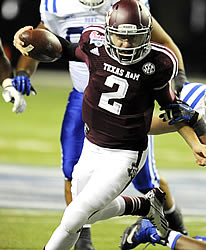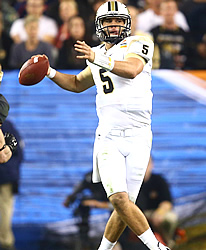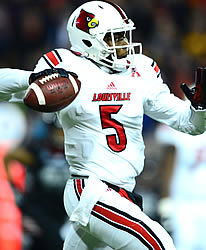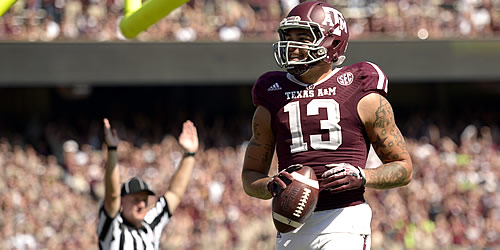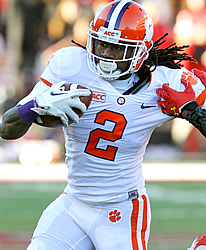 With draft day less than a month away, it’s time for an update. If you have any questions or comments, feel free to drop me a line on Twitter @thepigskinguy.
With draft day less than a month away, it’s time for an update. If you have any questions or comments, feel free to drop me a line on Twitter @thepigskinguy.
1. Houston Texans: Blake Bortles, QB Central Florida – Unless the Texans simply don’t like any of the top quarterbacks, this pick will be used to take one. I originally went with Teddy Bridgewater and while I think he is still a strong possibility, Bortles’ combination of talent, arm-strength and upside gives him a slight edge.
Previous Pick: QB Teddy Bridgewater
2. St. Louis Rams: Greg Robinson, OT Auburn – The Rams would probably like to trade out of this spot but if they stay, Robinson is a logical selection. If the Rams go offensive tackle here it will come down to which player they like more between Robinson and Jake Matthews.
Previous Pick: OT Greg Robinson
3. Jacksonville Jaguars: Jadeveon Clowney, DE South Carolina – Gus Bradley is a defensive minded coach and unless the Jaguars absolutely love one of the quarterbacks in this draft, it will be hard for them to pass up on a prospect like Clowney if he’s still on the board at three.
Previous Pick: DE Jadeveon Clowney
4. Cleveland Browns: Johnny Manziel, QB Texas A&M – Everyone on the planet appears to love Brian Hoyer but an organization needs more than just him at quarterback if they want to end decades of losing. The franchise needs a quarterback and a player to excite its fanbase. The drafting of Manziel will take care of both of those problems.
Previous Pick: QB Blake Bortles
5. Oakland Raiders: Sammy Watkins, WR Clemson – I actually have Watkins as the top overall player in this draft. I think he is the one can’t-miss prospect given all the physical attributes Watkins brings to the receiver position. That theory will be tested if he goes to Oakland but Watkins certainly fills a need for the Raiders. Oakland has some decent receivers but no one close to being in Watkins’ class. He will be a game-changer from Day 1.
Previous Pick: WR Sammy Watkins
6. Atlanta Falcons: Khalil Mack, DE Buffalo – Mack dominated in college and while some will point to the fact that he played in the MAC, he had some of his biggest games against top-level competition. I saw Mack play a couple of times against bigger schools and he was a terror coming off the edge. He will instantly help a dormant Falcons’ pass rush.
Previous Pick: DE Khalil Mack
7. Tampa Bay Buccaneers: Mike Evans, WR Texas A&M – The Bucs parted ways with Mike Williams and they really have few options beyond Vincent Jackson. After signing Josh McCown, it would be nice to give him a 6’5 receiver like Evans to throw the ball to in the red zone. Depending on how the draft shakes out early, Evans could very well end up in Tampa Bay.
Previous Pick: OT Jake Matthews
8. Minnesota Vikings: Teddy Bridgewater, QB Louisville – The Vikings re-signed Matt Cassel but will also add a young quarterback in the draft. Minnesota is reportedly high on Zach Mettenberger and so am I, so he is a possible target in Round 2 if they don’t select a quarterback here. However, I have a hunch Minnesota is also very high on Bridgewater and if he slips to them at eight, I don’t see the Vikings passing on him.
Previous Pick: QB Johnny Manziel
9. Buffalo Bills: Jake Matthews, OT Texas A&M – Matthews would be tough for Buffalo to pass up here, especially since the Bills are weak at right tackle. Matthews is a devastating run blocker and he has quick feet for a guy his size. Some NFL scouts think Matthews is the best OT in the draft, so this would be a great pick for the Bills at No. 9.
Previous Pick: WR Mike Evans
10. Detroit Lions: Darqueze Dennard, CB Michigan State – A lot of people like Justin Gilbert as the top corner because of his speed but I don’t think it’s close. Dennard was the best cover corner in college football last year. Denard is tough, smart and he would make a great addition to Detroit’s secondary.
Previous Pick: CB Darqueze Dennard
11. Tennessee Titans: Anthony Barr, LB UCLA – Barr could easily be a Top 10 selection given his ability and production in college. However, if Barr slips to 11, the Titans will have to strongly consider him. Tennessee can go in a lot of different directions but the Titans are in need of an explosive pass rusher and Barr fits the bill.
Previous Pick: LB Anthony Barr
12. New York Giants: Taylor Lewan, OT Michigan – The Giants had one of the worst offensive lines in the NFL last season and protecting Eli Manning is the team’s top priority. Lewan was one of the few bright spots on the worst coached team in college football last year once Lane Kiffin was fired.
Previous Pick: OT Taylor Lewan
13. St. Louis Rams: Ha Ha Clinton Dix, S Alabama – When your name is “Ha Ha” you should be drafted in the Top 15 by law. Dix is all over the field. I actually think he is one of the 10 best players in the draft at any position. The Rams safeties are dreadful. Dix would come in and be a huge upgrade to a defense that already has a nasty front seven.
Previous Pick: S Ha Ha Clinton Dix
14. Chicago Bears: Aaron Donald, DT Pittsburgh – How bad was the Bears’ rush defense last year? Ray Rice gained 131 yards on them. Chicago is one of the easiest teams to project. They badly need a defensive tackle or safety. If the talented Donald is on the board, he will be a strong possibility for the Bears. They need more than just Lamarr Houston.
Previous Pick: DT Timmy Jernigan
15. Pittsburgh Steelers: Justin Gilbert, CB Oklahoma State – Pittsburgh is a tough team to peg because they can go in many different directions like CB, TE, WR, OT or DL. I’m going with Gilbert here if he’s still on the board. Others are higher on Gilbert than I am but he has great speed and playmaking ability. I think Eric Ebron is another strong possibility for the Steelers.
Previous Pick: DT Aaron Donald
16. Dallas Cowboys: Calvin Pryor, S Louisville – The Cowboys signed Henry Melton but they still need a lot of help along their defensive front. However, safety has been a major weakness in Dallas’ defense for too long and a player with Pryor’s skill-set can finally put an end to that. If the Cowboys want to play the Tampa-2 scheme, they need better production out of the safety position. Pryor would be an excellent addition to their defense.
Previous Pick: DT Louis Nix
17. Baltimore Ravens: Odell Beckham, WR LSU – The Ravens added Steve Smith but I don’t believe they are done adding weapons for Joe Flacco. Beckham is a tough receiver that can go inside similar to Anquan Boldin, only with more speed. Beckham is one of the most underrated players in the draft. He has all the skills to be a star NFL receiver.
Previous Pick: WR Odell Beckham
18. New York Jets: Eric Ebron, TE North Carolina – Geno Smith took a lot of criticism in his first season and much of it was deserved. Still, the Jets had the worst group of receivers and tight ends in the NFL. New York added Eric Decker in free agency but the Jets still have to upgrade at tight end. Ebron is the top tight end prospect available and would represent great value if he were still on the board at 18. Just a word of warning: Tight ends always get mocked too high. Ebron could certainly go in the Top 15 but I doubt he gets selected in the Top 10. Teams simply value other positions more than they do tight end.
Previous Pick: TE Eric Ebron
19. Miami Dolphins: Zach Martin, OT Notre Dame – Martin was excellent during his career at Notre Dame. He dominated as a left tackle and Martin has the versatility to play multiple positions on the line early in his career. Given all the problems the Dolphins have with their offensive line right now, Martin would be an excellent selection for them.
Previous Pick: OT Zach Martin
20. Arizona Cardinals: C.J. Mosley, LB Alabama – We are getting to the point in the draft where value matters and while Arizona does need an outside linebacker, Mosley is too good to pass up here even if the position may not be the team’s most pressing need. Mosley would fit in nicely with one of the emerging defensive units in the NFL. My guess is he goes higher than 20 though, maybe even No. 9 to Buffalo.
Previous Pick: LB C.J. Mosley
21. Green Bay Packers: Timmy Jernigan, DT Florida State – The Packers need help along their defensive line and Jernigan is an explosive defensive lineman with plenty of upside. One of the things that really hurt Green Bay last year was a lack of depth along its defensive front. Jernigan can come in as a rookie and help make an impact in a rotational role.
Previous Pick: S Calvin Pryor
22. Philadelphia Eagles: Donte Moncrief, WR Ole Miss – I thought Moncrief was one of the top receivers in college football last season but he didn’t play with an elite quarterback. I also believe NFL people think much more highly of him than draftniks on the Internet. Finally, I believe Chip Kelly knows an offensive stud when he sees one. The Eagles are looking for a big receiver to make plays on the outside. Moncrief could be that guy but either way I predict he will be drafted in Round 1.
Previous Pick: CB Justin Gilbert
23. Kansas City Chiefs: Marqise Lee, WR USC – The Chiefs need more gamebreakers on offense and Lee would be a bargain this low for Kansas City. Lee is slipping in some circles but you have to look at his college situation. When a guy still puts up good numbers despite playing for the worst coach on the planet, it says a lot. Lee would be a nice fir in Andy Reid’s offense.
Previous Pick: WR Marqise Lee
24. Cincinnati Bengals: Kony Ealy, DE Missouri – The Bengals lost Michael Johnson to free agency, so Ealy will help Cincinnati upgrade at a vital position. Ealy is a quick edge rusher who is also strong against the run. He can step in and rotate with Carlos Dunlap and Margus Hunt as a rookie.
Previous Pick: DE Kony Ealy
25. San Diego Chargers: Louis Nix, DT Notre Dame – Nix is the top pure nose tackle in this draft and he would be a great fit in San Diego’s 3-4 defense. Nose tackle aren’t easy to find, so getting a dominant run stuffer like Nix at this point would be a steal for the Chargers.
Previous Pick: G David Yankey
26. Cleveland Browns: Brandin Cooks, WR Oregon State – The Browns are picking here because the Colts thought they said “sixth round” pick instead of “first round” pick for Trent Richardson. Cleveland has many needs but Josh Gordon is really the only threat the Browns have at receiver. The explosive Cooks would change that, along with giving Cleveland a dangerous return man.
Previous Pick: WR Brandin Cooks
27. New Orleans Saints: Dee Ford, DE Auburn – Ford dominated last year in the SEC and if he goes to the right team like the Saints, he has a chance to be a stud in the NFL. I won’t be surprised if someone like the Steelers grab him higher in the draft but if Ford lasts this long, Rob Ryan will love him.
Previous Pick: DE Dee Ford
28. Carolina Panthers: Kelvin Benjamin, WR Florida State – If a top receiver is on the board at 28, I have to think the Panthers will pull the trigger. Right now I think I’m projected to be Carolina’s fourth receiver. The 6’5 Benjamin would give Cam Newton a huge target, especially in the red zone. Benjamin is slipping because of some off-the-field concerns but his physical skills still make him a possibility for the Panthers at 28.
Previous Pick: WR Kelvin Benjamin
29. New England Patriots: Jace Amaro, TE Texas Tech – This is the popular pick for the Patriots. I originally had Kyle Fuller going to New England and I still think he’s the kind of player the Patriots could target but after signing Darrelle Revis, I’m going with Amaro. Rob Gronkowski is coming back from his second major injury and there is little behind him at tight end. Amaro would give Tom Brady another dangerous weapon in the passing game.
Previous Pick: CB Kyle Fuller
30. San Francisco 49ers: Kyle Fuller, CB Virginia Tech – The 49ers don’t have many weaknesses but one area where they could stand to upgrade is at cornerback, especially after losing Carlos Rogers. Fuller is a smart, tough, versatile corner that will fit in perfectly with what the 49ers like to do on defense.
Previous Pick: CB Bradley Roby
31. Denver Broncos: Ra’Shede Hageman, DL Minnesota – The Broncos could grab an OT here to protect Peyton Manning but with Robert Ayers and Shaun Phillips both gone, defensive line is an area of need as well. Besides, if Hageman lasts this long, the versatile lineman will be one of the top players left on the board.
Previous Pick: DL Ra’Shede Hageman
32. Seattle Seahawks: Ryan Shazier, LB Ohio State – Seattle usually takes the best player available. I wanted to mention Shazier because in my opinion, he’s going to be a difference-maker in the NFL. A couple of years ago I really liked Lavonte David coming out of Nebraska and Shazier reminds me a lot of him. He’s always around the ball making plays. Whichever team selects Shazier is going to get a future stud. Don’t be surprised if he goes in Round 1. If Shazier is still on the board here, Seattle will likely give him a long look.
Previous Pick: TE Jace Amaro

